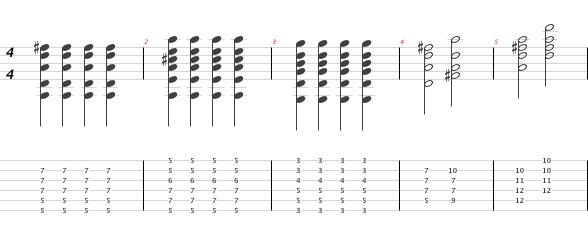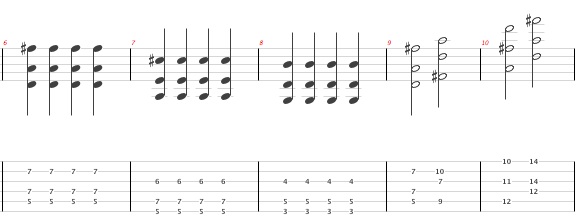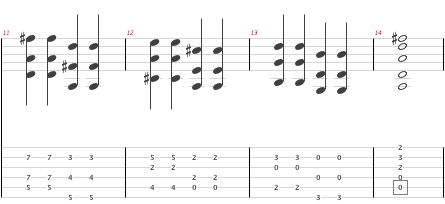Spread Triads: Making the Guitar Sound Beautiful

This week, it's all about making the guitar sound as beautiful as possible. For me, the masters of this are Eric Johnson and Tim Miller (who was my teacher at one point). We'll get to what they both do that sounds very unique. We'll also go over ways I like to doll up some otherwise normal-sounding guitar parts. The first and easiest way is to open up your chords. I mean use spread triads.
This is super helpful in creating a clear sound—the kind of sound a lot of people get surprised by.
EXAMPLE 1 is an normal yet mildly crowded way to play D–A–G. Here we have five notes played in this D chord and six played in the A and G chords. This sounds nice and full and very familiar as a “guitar” sound.

In EXAMPLE 2, we break down the chords to three notes. It's still a full chord (triad, the root-third-fifth), just arranged in a fun way. Here we have the D chord spelled out root-fifth-third low to high D-A-F#, the A chord A-E-C# and the G chord G-D-B. As you'll be able to hear, it makes for a much clearer representation of the chords. At the end I go through all the D inversions. An inversion is just a different order of the same notes. The orders go 1-5-3, 3-1-5, 5-3-1 then 1-5-3 again.

EXAMPLE 3 goes through inversions of all the chords and makes a nice melody on the high strings. Spread triads make an ignorable guitar part stand out dramatically.

Tim Miller is a great example of someone using spread triads and very clear chord voicings in general. I'd highly suggest listening to his Trio Vol. 2 album and the song “Night Sky” as examples of amazing chord work.
The other is a more familiar name: Eric Johnson. We all know and butcher our own version of "Cliffs of Dover," but if you listen to his clean chord playing, it's clear he has thought a lot about chord voicings. Check out basically any live intro to "Cliffs of Dover" for an example.
Another way to make things pretty is by keeping the open strings ringing.
EXAMPLE 4 is the same chords as the previous spread triad examples but with open strings and moving inversions. I know this last example has nothing to do with spread triads, but it does have to do with making the guitar sound beautiful!

Moving from D to G while keeping the low note an open D string also gives the part a piano-y vibe (to me). Using open strings when applicable gives some freedom to your fretting hand to wander about and make melodies while still sounding like intended chord. Hope this helps! Feel free to post any questions in the comments section.
Elliott Klein is a New York City-based guitarist/singer/songwriter who plays in Bright and Loud, Party Lights and many more.
Get The Pick Newsletter
All the latest guitar news, interviews, lessons, reviews, deals and more, direct to your inbox!










